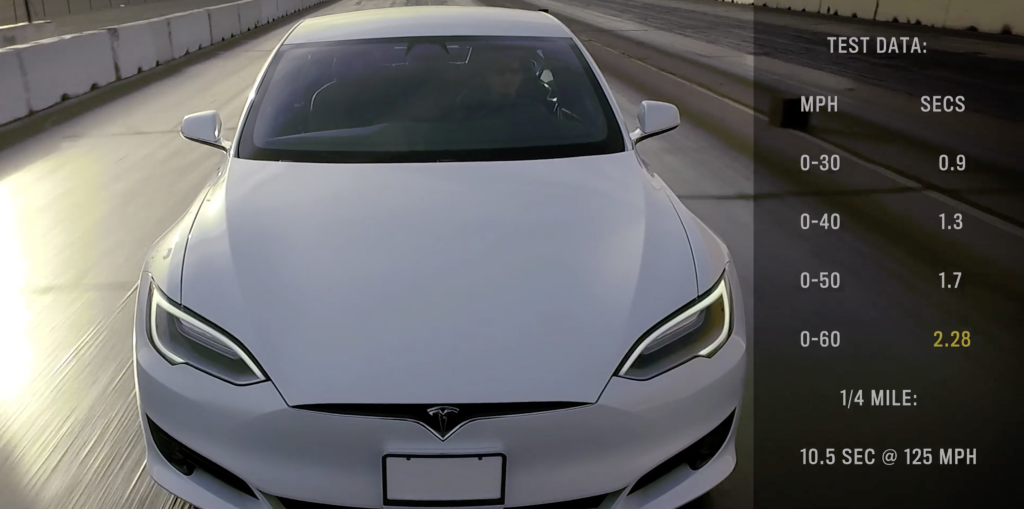For quick electric autos, ceasing their battery weight is essential, as well
My keen companion Doug Milliken sent me an email a few days ago to ask, “Whatever happened to 0–100–0 testing?” The 0–60 wars between Tesla, Faraday Future, and Lucid has Milliken feeling that these all-wheel-drive electric autos must quicken about as hard (in g powers) as they can brake—at the breaking points of their tires in both headings of main thrust.
Adventitiously, I’d quite recently ridden in both the Faraday and Lucid autos amid late showing speeding up runs, and we were adapting to test the Tesla Model S P100D, which Elon Musk asserted could dash to 60 mph in 2.3 seconds. Faraday is touting 2.39 seconds to 60 mph for its 91, and Lucid has 2.5 seconds for its Air. Suppose 2.3, 2.4, and 2.5 seconds—every one of the three twist drive in front of the 3.2 seconds we’ve recorded for the snappiest cylinder thrashing five-situate car in our tried execution list, an Audi RS7 from 2014. (We’re trying another one soon.)
What’s making every one of the three of these numbers so strange is an intersection of innovations and structures that—to give credit where it’s merited—totally follows to Elon Musk’s small time makeover of how we see electric cars. Keep in mind those “it’s only a celebrated golf truck” days? The sun set on that like a dropped fortification buster bomb with Tesla’s unique Roadster, which in our grasp ErrrrEEEEEed to 60 mph in an astounding 3.7 seconds. Furthermore, it’s conceivable that the model two-speed variant may have eventually guaranteed much more noteworthy increasing speed, however the light-switch surge of max torque at the 1-2 upshift continued devastating transmissions. So the principal lines on our plan for mid-2-second-car increasing speed were drawn—an electric engine and a strong, single-speed decrease gearset.
The Model S that took after included two more parameters that would in the end however not promptly have level with hugeness to speeding up: a long wheelbase and a huge, level hotcake battery between the auto’s axles. All alone, neither of these is really useful at the dragstrip in light of the fact that they diminish weight exchange to the back wheels. That is the reason raise motor and back drive Porsche 911s can humiliate what we consider as legitimate racing autos with their overwhelming front motors and daintily stacked back tires. In such manner, the Roadster’s tall, raise one-sided, square shaped battery (and its high focal point of gravity) was a useful accomplice in squeezing the Roadster’s back wheels to the black-top.
In any case, the double engine Model S changed everything. The perplex pieces all of a sudden fit. At its presentation, I was honestly under the feeling that the new front engine, new front axles, and modified suspension were all perceptively cooked into the auto’s ground breaking strategy from the earliest starting point. Presently, I’m not entirely certain. It was obviously their definitive goal, yes. Be that as it may, in reality, a great deal of updating was important. What’s more, here at the dragstrip, at any rate, it was well justified, despite all the trouble.
Furthermore, that is on the grounds that the outcome is fundamentally the ideal engineering for quickening. That long wheelbase, low focus of gravity, and almost adjusted weight appropriation all of a sudden tee up rankling increasing speed conceivable outcomes when each of the four wheels are driven. You don’t need rearward weight exchange any longer—truth be told, now it’s the foe of perfect.
The advantage from about multiplying the tire impression is really self-evident. What won’t not be is an undetectable wonder; the proficiency of a tire’s ability to convey hold reduces as the tire’s downforce out and about ascents. With AWD (expecting tire sizes that aren’t too much amazed), you really need to limit weight exchange. That is, it’s path better to convey the Tesla’s torque to each of the four wheels than hypothetically stand the auto and all its weight on two driven back tires alone. Consolidate this with wheel-slip control that is outlandish in a gas auto, and the outcome is a format so perfect that it’s difficult to envision how to better it. The FF 91’s autonomous back engines could eventually react much more unequivocally to their friend wheel’s slipping. Be that as it may, you’re essentially left snacking at the edges. Our test auto’s unique, lighter new wheels decrease rotational latency, as well.
The obvious issue at hand, however, is the profundity of the enormous battery, which may not by any means be counterbalanced by aluminum development and minimized engines. That circles us back to why I raised an awed eyebrow when I read Doug’s email. Since natural for these AWD, electric-engine, level battery rocket sleds is the expanded test of halting them. As such, the 0–100–0 test rapidly catches both their quickening and ceasing characteristics—the great and perhaps the terrible.
The 0–100–0-mph test has a long history, most broadly going back to Carroll Shelby’s 1965 427 Cobra setting a period of 13.8 seconds with driver Ken Miles at what might later get to be Los Angeles International Airport. Frankly, I’ve generally imagined that number was unadulterated publicity from the wily old chicken rancher. Truth be told, numerous years prior I attempted to recreate it in a 427 claimed by Shelby at the Pomona dragstrip. With the considerable man himself admonishing me to take a stab at moving at ever-higher revs (and his repairman behind him waving “no-no!”), I at long last exploded the motor attempting.
With the Tesla P100D, we’re taking a gander at the math: expansion of the auto’s 0–100-mph time and its 100–0-mph halting seconds, caught amid our standard testing. In part, it’s a convenience since we didn’t have sufficient energy to play out the entire 0–100–0 bazaar, which requires included hardware and bunches of rushes to get an agent illustration. In any case, it likewise comes the matter down to what’s truly the auto’s fundamental execution. (Foot move time from gas to brake pedal can shift a considerable measure—from 0.2 to perhaps 0.5 second.) OK, I concur. I’m a sentimental, as well, and I cherish the possibility of really doing the total test. Be that as it may, this surely makes for a clearer, more exact picture of execution.
The outcome? The P100D catches a consolidated time of 10.2 seconds—that is 6.0 seconds to 100 mph and 4.2 more to stop once more. What’s that mean? Here it is underneath, recorded with regards to autos we’ve also tried amid the previous couple of years:
| Order | Year | Make | Model | 0-100-0 MPH, SEC | Curb Weight, LB |
| 1 | 2016 | McLaren | 675LT | 9.3 | 2,993 |
| 2 | 2017 | Porsche | 911 Turbo S | 9.7 | 3,557 |
| 3 | 2017 | Audi | R8 V10 Plus | 10 | 3,642 |
| 4 | 2016 | McLaren | 570S | 10.1 | 3,188 |
| 5 | 2017 | Tesla | Model S P100D | 10.2 | 4,891 |
| 6 | 2017 | Acura | NSX | 10.9 | 3,876 |
| 7 | 2016 | Mercedes-AMG | GT S | 10.9 | 3,698 |
| 8 | 2017 | Chevrolet | Camaro ZL1 | 11.1 | 3,926 |
| 9 | 2016 | Dodge | Viper ACR | 11.1 | 3,379 |
| 10 | 2017 | Nissan | GT-R (Premium) | 11.3 | 3,936 |
| 11 | 2017 | Porsche | 911 Carrera S | 11.7 | 3,353 |
| 12 | 2017 | Aston Martin | DB11 | 12.1 | 4,194 |
| 13 | 2017 | Chevrolet | Corvette Grand Sport (8A) | 12.2 | 3,479 |
| 14 | 2017 | Jaguar | F-Type SVR | 12.2 | 3980 |
| 15 | 2017 | Alfa Romeo | Giulia Quadrifoglio | 12.3 | 3,749 |
| 16 | 2017 | Chevrolet | Corvette Grand Sport (7M) | 12.4 | 3,464 |
| 17 | 2016 | BMW | M4 GTS | 12.5 | 3,605 |
| 18 | 2016 | Ford | Mustang Shelby GT350R | 12.5 | 3,711 |
| 19 | 2016 | BMW | M3 (Competition pack) | 12.9 | 3,646 |
| 20 | 2017 | Chevrolet | Camaro SS 1LE | 13.1 | 3,735 |
| 21 | 2017 | Porsche | 718 Boxster S | 13.1 | 3,160 |
| 22 | 2017 | Aston Martin | V12 Vantage S | 13.3 | 3,677 |
| 23 | 2017 | Mercedes-AMG | SLC43 | 14.8 | 3,594 |
| 24 | 2016 | BMW | M2 | 15.2 | 3,440 |
| 25 | 2017 | Mercedes-AMG | E43 4Matic | 15.7 | 4,309 |
| 26 | 2017 | Mercedes-AMG | GLC43 4Matic | 16.5 | 4,256 |
| 27 | 2017 | Porsche | Macan GTS | 16.5 | 4,501 |
| 28 | 2017 | Chevrolet | Camaro 2LT 1LE | 17.2 | 3,514 |
| 29 | 2017 | Alfa Romeo | Giulia | 17.6 | 3,456 |
See that you need to sweep the distance down to the Alfa Romeo Giulia Quadrifoglio before you experience the following five-situate vehicle—and that is 2.1 seconds slower and 1,142 pounds lighter. What’s astounding here is not recently that the Tesla is fifth on our rundown additionally how it’s swimming in an indistinguishable pool from some out and out ocean creatures, for example, the McLarens and the Mercedes-AMG GT S, while supporting a gigantic battery pack rather than a little gas tank. Goodness, and it has those three back seats and a natural hollow of load space, as well.
To explicitly address Doug’s unique point about g constrains, the P100D is conveying more than 1.0 g from 2.4 mph to 46 mph and the whole time it’s braking. That is 5.7 seconds of its 10.2-second run—56 percent of it—over 1 g. While the 0–100–0-mph test was constantly sort of a sideshow execution test you’d do as an oddity, going ahead, when the FF 91, Lucid Air, and Porsche Mission E at long last arrive (fingers crossed), it’s really going to matter.




